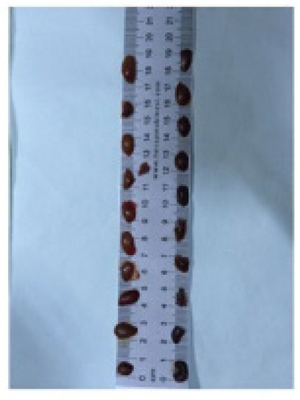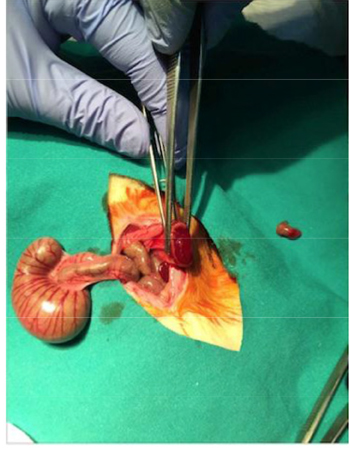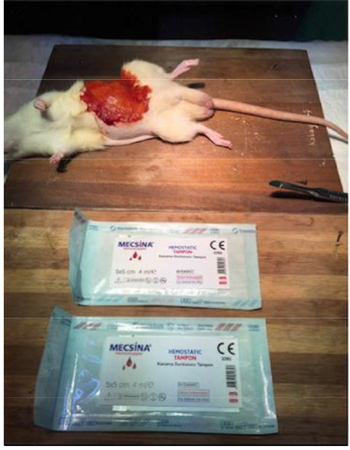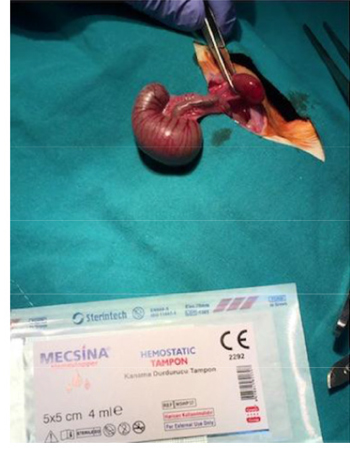Previous Issues Volume 2, Issue 1 - 2018
Use of Mecsina Hemostopper Tampon as a Hemostatic Agent to Stop Bleeding in Partial Nephrectomy: First Experimental Study in Rats
Selcuk Sarikaya1,Cihat Ozcan1,Erdem Ozturk2,Nurullah Hamidi3
Corresponding Author:Selcuk Sarikaya,Gulhane Egitim ve Arastirma Hastanesi, General Tevfik Saglam Caddesi Etlik/Ankara, Turkey Tel: +905316274819; Email: [email protected]
Received Date: 10 Oct 2018 Accepted Date: 16 Oct 2018 Published Date: 19 Oct 2018
Copyright © 2018 Sarikaya S
Citation: Sarikaya S, Ozcan C, Ozturk E and Hamidi N. (2018). Use of Mecsina Hemostopper Tampon as a Hemostatic Agent to Stop Bleeding in Partial Nephrectomy: First Experimental Study in Rats. Mathews J Urol Nephrol 2(1): 009.
INTRODUCTION
According to the advanced radiologic techniques, the incidences of renal tumor has increased during the past decades [1]. Considering the improvements in surgical techniques, partial nephrectomy is highly recommended for clinically localized tumor in European Association of Urology and American Urological Association guidelines [1-3]. As per the estimated Glomerular Filtration Rate (eGFR) results in early and late postoperative periods, partial nephrectomy is the better choice for renal function preservation [4]. Hemorrhage is one of the most mortal and major complications after surgeries [5- 7]. Generally hemorrhage scan be controlled conservatively, but sometimes it can be life-threatening [5, 8]. Literature has reported about many hemostatic agents that have been used to control bleeding in laparoscopic and open surgeries [9]. As stated in literature, Thompson and Bergel identified tissue sealants and dry plasma, respectively, as hemostatic agents [10, 11]. Different studies were performed in past to analyze the success rates of different hemostatic agents [11, 12], out of which synthetic agents were found to be the highest scorers [11]. Several other studies were also designed in order to study the efficacy of natural, herbal, and folkloric agents [13- 15], which usually help conventional agents such as ligature, pressure, and cautery for hemostasis[14, 16, 17] . Mecsina Hemostopper is a plant based product containing Glycyrrhiza glabra extract, Alpinia officinarum, Thymus serpyllum, Syzygium aromaticum, Hypericum perforatum, Vitis vinifera, Urtica angustifolia, and Mentha arvensis. The main mechanism of Mecsina hemostopper is to create a mechanical tampon compress & protein network, especially with fibrinogen. After network formation, red blood cells enter into the network formation that provides more oxygen to the bleeding area resulting in a fast tissue recovery. In this study, we aimed at analyzing the efficacy and reliability of Mecsina hemostopper as a safe hemostatic medical device.
Figure 1: A total of 20 partial nephrectomy image, material size are close together
Mecsina hemostopper Tampon (5x5 cm) was used for group 1 rats during operations (Figure 2 & 3), whereas the group 2 rats were operated without any hemostatic material. Although considered as a first choice for minimizing the parenchymal bleeding, the renal hilar vascular control method was also not used. (Figure 4) Preoperative and postoperative hemoglobin levels, hematocrit levels, hematoma formation, and average blood loss were assessed in both the groups.
Figure 2: Post partial nephrectomy.
Figure 3: Left flank incision was performed.
Figure 4: Prior to partial nephrectomy.
STATISTICAL ANALYSIS
Student T test was used to compare variables (hemoglobin and hematocrit levesl) within the groups and Wilcoxon test was used to compare variables (hemoglobin and hematocrit changes) of different groups. Preoperative hemoglobin and hematocrit levels were not compatible with normal distribution, the other variables were compatible.
RESULTS
The partial nephrectomy operation was conducted under general anesthesia where the right middle poles of rats' kidney were excised without implementing hilar vascular control technique, and the primary repair was performed with 5/0 vicryl. On the first postoperative day, the hemoglobin and hematocrit levels were analyzed. The average preoperative hemoglobin level was 12.6 g/dl for group 1 and 13.8g/dl for group 2. The average postoperative hemoglobin level was 11.4g/dl group 1 and 12.7g/dl for group 2. The average decrease in hemoglobin level was 1.2g/dl for group 1 and 1.1g/ dl for group 2. The average preoperative hematocrit level was 37.9% for group 1 and 41.1%for group 2. The average postoperative hematocrit level was 34.3% for group 1 and 37.7% for group 2. The average decrease in hematocrit level was 3.7% for group 1 and 3.4%for group 2. After the first postoperative week, only one hematoma formation was observed in group 1 and two in group 2. The volume of hematoma formations in both the groups of rats were nearly 0.2cc each. Hematoma formation is an important factor for comparing two groups and in the group that bloodstopper was used there was only one hematoma formation.
On the first postoperative day, no deaths were recorded due to the operation. The tissue samples were fixed with 4% formaldehyde followed by histopathologic analyses.
Considering the experimental results, Mecsina Hemostopper Tampon was found to be safe for being used during the partial nephrectomy operations in order to control bleeding.
According to the statistical analysis, there were statistically significant differences within the groups in terms of preoperative and postoperative hemoglobin levels, preoperative and postoperative hematocrit levels(p<0,05) When comparing the the two groups in terms of hemoglobin and hematocrit levels, there were not statistically significant differences. (z=0,204 ; p>0,05, z=0,180 ; p>0,05 respectively)
DISCUSSION
The increased use of radiologic techniques and its recent developments resulted in the early diagnosis of renal tumors [1, 4]. With regarding to the surgical improvements, similar oncologic outcomes have been observed in partial nephrectomy compared to the radical nephrectomy operations[1, 4, 9, 14, 15], thereby recommending the former one as an improved surgical technique for clinically localized tumors[2, 3]. Many surgical techniques have been designed, such as laparoscopic approach and robotic approach, for kidney, and at times difficulties are faced in controlling the renal parenchyma bleeding.
There have been several conventional methods that are usually used for bleeding control during the partial nephrectomy operations [14]. Technological improvements have provided new synthetic and herbal materials for hemostasis[1, 2, 4, 5, 7, 12, 13, 18]. Several studies have revealed about the safety and reliability of such hemostatic agents [1, 5, 9, 15, 19]. According to all these experimental studies, it is clearly seen that these hemostatic agents have a crucial efficacy in control blood flow [20]. In our study, we aimed at showing the effects of Mecsina Hemostopper as a hemostatic Tampon. The plant based Mecsina Hemostopper Tampon had similar results on postoperative hemoglobin and hematocrit levels. The hemorrhage and blood loss in both the rat groups were also similar. When comparing the hematoma formation and the average blood loss in both the groups there were similar results and there was no significant difference. The number of hematoma formation was detected to be lower in Mecsina Hemostopper group but it is better to discuss this issue with conducting studies including larger groups.
LIMITATIONS
It would be better to conduct these types of studies with larger study groups. Large randomized studies would be useful to assess efficacy and safety of these products.
CONCLUSION
As a result, Mecsina Hemostopper Tampon can be considered as a safe hemostatic agent to control bleeding during partial nephrectomy surgeries. However, more studies with larger experimental groups and human subjects must be performed for better results.
REFERENCES
- Huri E, Akgul T, Ayyildiz A, Bagcioglu M, et al. (2010). First clinical experience of Ankaferd BloodStopper as a hemostatic agent in partial nephrectomy. Kaohsiung J Med Sci. 26(9): 493-495.
- Ljungberg B, Bensalah K, Canfield S, Debestani S, et al. (2015). EAU guidelines on renal cell carcinoma: 2014 update. Eur Urol. 67: 913-924.
- Donat SM, Diaz M, Bishoff JT, Coleman JA, et al. (2013). Follow-up for clinically localized renal neoplasms: AUA Guideline. J Urol. 190(2): 407-416.
- Miyamoto K, Inoue S, Kajiwara M, Teishima J, et al. (2012). Comparison of renal function after partial nephrectomy and radical nephrectomy for renal cell carcinoma. Urol Int. 89(2): 227-232.
- Tokgoz H, Karakaya K, Hanci V, Abdusoglu M, et al. (2010). Protective value of a folkloric medicinal plant extract against mortality and hemorrhage in a life-threatening renal trauma model. Urology. 75(6): 1515. e9-1515.e14.
- Shackford SR, Mackersie RC, Holbrook TL, Davis JW, et al. (1993). The epidemiology of traumatic death. A population-based analysis. Arch Surg. 128(5): 571-575.
- Bjorses K and Holst J. (2009). Topical haemostatics in renal trauma an — evaluation of four different substances in an experimental setting. J Trauma. 66(3): 602-611.
- Burch JM, Ortiz VB, Richardson RJ, Martin RR, et al. (1992). Abbreviated laparotomy and planned reoperation for critically injured patients. Ann Surg. 215(5): 476-483.
- Yalcinkaya FR, Kerem M, Guven EO, Gokce A, et al. (2011). The effect of Ankaferd to stop bleeding in experimental partial nephrectomy. Bratisl Lek Listy. 112(12): 676-678.
- Thompson T, Chi-Fai N and Tolley D. (2003). Renal parenchymal haemostatic aids: glues and things. Curr Opin Urol. 13(3): 209-214.
- Bergel S. (2009). Ueber Wirkungen des Fibrins: Dtsch Med Wochenschr. 35(15): 633-665.
- Ferretti L, Qiu X, Villalta J and Lin G. (2012). Efficacy of bloodstop iX, surgicel, and gelfoam in rat models of active bleeding from partial nephrectomy and aortic needle injury. Urology. 80(5): 1161.e1-1166.e6.
- Wang PF, Chiu AW, Lin YM, Lin CY, et al. (2014). Effect of fibrin sealant aided with Dexon mesh for renal repair in a rat model of partial nephrectomy. Int J Surg. 12(4): 304- 309
- Tokgoz H, Bektas S, Hanci V, Erol B, et al. (2011). Postoperative adhesions after application of topical hemostatic agents: outcomes in a rat partial nephrectomy model. Urology. 78: 970.e9-970.e14
- Huri E, Akgul T, Ayyildiz A, Üstün H et al. (2009). Hemostatic role of a folkloric medicinal plant extract in a rat partial nephrectomy model: controlled experimental trial. J Urol. 181(5): 2349-2354.
- Mousa SA, Al Momen A, Al Sayegh F, Jaouni S, et al. (2010). Review. Management of Painful Vaso-Occlusive Crisis of Sickle-Cell Anemia: Consensus Opinion. Clin Appl Thromb Hemost. 16(4): 365-376.
- Ogan K, Jacomides L, Saboorian H, Koeneman K, et al. (2003). Sutureless laparoscopic heminephrectomy using laser tissue soldering. J Endourol. 17(5): 295-300.
- Chalupova M, Suchy P, Prazanova G, Bartsova L, et al. (2012). Local tissue reaction after the application of topical hemostatic agents in a rat partial nephrectomy model. J Biomed Mater Res A. 100(6): 1582-1590.
- Lassen MR, Haas S, Kreutz R, Mantovani LG, et al. (2016). Rivaroxaban for Thromboprophylaxis After Fracture-Related Orthopedic Surgery in Routine Clinical Practice. Clin Appl Thromb Hemost. 22(2): 138-146.
- MacEachern K, Kaur H, Toukh M, Mumal I, et al. (2015). Comprehensive Evaluation of Hemostasis in Normal Women: Impact on the Diagnosis of Mild Bleeding Disorders. Clin Appl Thromb Hemost. 21(1): 72-81.



